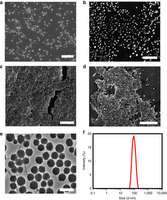Bionic particles self-assemble to capture light

Inspired by fictional cyborgs like Terminator, a team of researchers at the University of Michigan and the University of Pittsburgh has made the first bionic particles from semiconductors and proteins.
These particles recreate the heart of the process that allows plants to turn sunlight into fuel.
"Human endeavors to transform the energy of sunlight into biofuels using either artificial materials or whole organisms have low efficiency," said Nicholas Kotov, the Florence B. Cejka Professor of Engineering at the University of Michigan, who led the experiment.
A bionic approach could change that.
The bionic particles blend the strengths of inorganic materials, which can readily convert light energy to electron energy, with biological molecules whose chemical functions have been highly developed through evolution.
The team first designed the particles to combine cadmium telluride, a semiconductor commonly used in solar cells, with cytochrome C, a protein used by plants to transport electrons in photosynthesis. With this combination, the semiconductor can turn a ray from the sun into an electron, and the cytochrome C can pull that electron away for use in chemical reactions that could clean up pollution or produce fuel, for instance.
To drive reactions, the molecules of cytochrome C and nanoparticles of cadmium telluride must exchange electrons. This process would be most efficient if the components were connected, so the team designed a process that would allow them to self-assemble into superparticles.
U-M's Sharon Glotzer, the Stuart W. Churchill Professor of Chemical Engineering, who led the simulations, compares the self-assembly to the way that the surfaces of living cells form, using attractive forces that are strong at small scales but weaken as the structure grows. Kotov's group confirmed that the semiconductor particles and proteins naturally assemble into larger particles, roughly 100 nanometers (0.0001 millimeters) in diameter.
The team built on this formula for their test reaction. They turned the pollutant nitrate into nitrite and oxygen, demonstrating that the bionic particles could harness sunlight to drive chemical reactions. For this process, the semiconductor and cytochrome C needed help from other enzymes, which the team incorporated into the superparticles.
"We merged biological and inorganic in a way that leverages the attributes of both to get something better than either alone," Glotzer said.
Powered by electrons from the cytochrome C, the enzyme could remove oxygen from nitrate molecules.
Like the structures that accomplish photosynthesis in plants, the bionic particles took a beating from handling the energy. Nature constantly renews these working parts in plants, and through self-assembly, the particles may also be able to renew themselves.
Kotov said they could potentially work in a cycle that allowed the particles time to reassemble after wearing down with use. He explained that the self-assembly occurs because the two types of building blocks are of similar size and charge.
"If the inorganic nanoparticles are too small they will not assemble. Too big, and they unravel the proteins," he said. "And, if the nanoparticles and proteins have opposite charges, they form big clumps and fall out of the solution."
Glotzer said that now that they understand how the assembly phenomena works, "we can find design principles both to optimize conditions and to extend our findings to other types of nanoparticle-protein systems."
One goal is the conversion of carbon dioxide and water into natural gas, which would allow much of the current energy infrastructure to continue working with no net carbon emissions. But the team considers more than just artificial photosynthesis applications.
"These design principles can be used to guide future designs for other bionic systems, starting from the primary building blocks of biological organisms and inorganic machines," Kotov said. "It is very possible that Terminator of the future would need to be constructed starting from such building blocks."
More information: "Terminal supraparticle assemblies from similarly charged protein molecules and nanoparticles." Jai Il Park, et al. Nature Communications 5, Article number: 3593 DOI: 10.1038/ncomms4593. Received 17 December 2013 Accepted 07 March 2014 Published 20 May 2014
Journal information: Nature Communications
Provided by University of Michigan



















